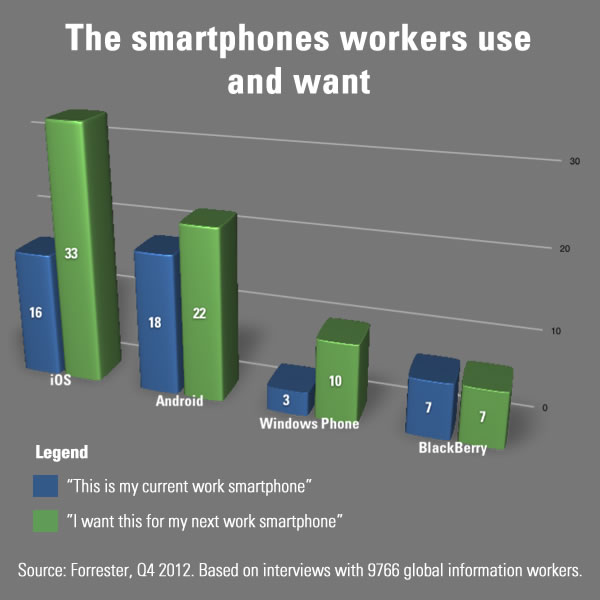
This article also appears in Mobilize!: The CTS Mobile Tech Blog.
 If people you know are trying to work their way through the hedge maze of letting employees bring their own devices to work, give them the free ebook The Executive’s Guide to BYOD and the Consumerization of IT. It’s a collection of what TechRepublic and ZDNet consider to be some of their best recent articles on the topics of BYOD and its older, more generic cousin, the consumerization of IT.
If people you know are trying to work their way through the hedge maze of letting employees bring their own devices to work, give them the free ebook The Executive’s Guide to BYOD and the Consumerization of IT. It’s a collection of what TechRepublic and ZDNet consider to be some of their best recent articles on the topics of BYOD and its older, more generic cousin, the consumerization of IT.
Here’s a list of the articles contained within the book:
Once again, the book is free. If you’re a member of TechRepublic, you can download it immediately; if you’re not, you’ll have to register first (it’s free).

In our previous post, we featured Forrester Research’s Mobile Workforce Adoption Trends report — yours for the low, low, low price of US$2495 — and showed some data on what smartphones and tablets were used and wanted by nearly 10,000 information workers in 17 countries surveyed.
Here are a few more tidbits from the report that you might find useful or interesting. Alas, we don’t have the “two and a half large” to spare for the full report, so we’re working with material culled from the report from sites with larger budgets.

IDC Canada’s Canadian Mobile Worker 2012–2016 Forecast — priced at CA$4,500, which makes Forrester’s Mobile Workforce Adoption Trends report look like a bargain — suggests that mobile workers are the new norm. They define a mobile worker as someone who does some of their work each week outside the office. 68.9% of employed Canadians — 12.1 million in total — fell into this category in 2012. They predict that by 2016, this fraction will climb to 73%, or 13.3 million working Canucks.
The Globe and Mail interviewed the author of IDC Canada’s report, Krista Napier, a senior analyst at IDC and also a board member at Toronto’s Mobile Experience Innovation Centre. Some quick hits from the interview:
This article also appears in Mobilize! The CTS Mobile Tech Blog.

Forrester Research’s recent Mobile Workforce Adoption Trends report (yours for the price of US$2,495) is based on a survey of nearly 10,000 information workers from 17 countries, in which they were asked about their usage of desktop, laptop, and mobile devices. We didn’t spring for the full report, but we were able to glean some numbers from online sources and we’ll share them below.

The photo at the top of this article of my own work setup: laptop, tablet and smartphone. As someone who uses three or more devices and works from a number of locations, Forrester would classify me as an “Anytime, anywhere” worker. Forrester’s report says that 23% of the workers surveyed in 2011 fell into this category; in 2012, that number increased by a quarter to 29%, meaning that nearly a third have three or more devices and move around a lot.

Back in January, we pointed to a ComScore MobiLens report that indicated that the smartphone world is an Android/iOS duopoly, with Android taking 54% of the market and Apple taking 35%. The duopoly also exists in the business world, but it’s a much closer race, with Android taking 37% of the market, with iOS following closely behind at 34%. BlackBerry users make up 15%; Forrester also reports that in the financial sector, this share is 26%, and across North America, their share is 20%.

The workers surveyed were also asked what smartphones they currently had and which ones they wanted. Android has a slight lead over iOS in terms of currently-used phones, but iOS is ahead by 50% when it comes to the “What I want for my next smartphone” category. It appears that the BlackBerry camp are sticking with their devices; I’m sure a good number of them are the sort who love their physical keyboards. The surprise is the number of people who want their next phone to be a Windows Phone: 10% of those surveyed.

As we expected (see this earlier article of ours), the iPad is the most-used tablet among those surveyed, with over twice the share of the runner-up, Android. Windows tablets make up for 11%; since this survey was taken in the fourth quarter of 2012, it’s likely that many of these tablets aren’t Surface RTs runnign Windows RT, but Windows 7 “slates” such as Samsung’s Series 7.

The growing demand for tablets at work isn’t surprising. What is surprising is the demand among those surveyed for a Windows tablet as their next work tablet. Surface sales have been slow, which suggests that what people want is a tablet that can run desktop Windows applications and not just Windows RT apps. The Surface Pro might appear to be that machine at first blush, but it looks as though it lives in that neither-here-nor-there netherworld between tablet and laptop.
This article also appears in Mobilize!: The CTS Mobile Tech Blog.

 NSCoderTO, a Toronto-based Mac/iOS coder group, is dedicating a series of book club meetups to Learning Cocos2D, an iOS game programming book written by Rod Strougo and Ray Wenderlich (the guy behind the ever-so-useful RayWenderlich.com site). Between now and late April, they’re going to read and do the exercises in this book, meeting up 5 times during that period to discuss their progress and any issues encountered along the way. You can take a look at the full schedule to see when you should be reading and doing the exercises in each chapter and when the meetups will take place.
NSCoderTO, a Toronto-based Mac/iOS coder group, is dedicating a series of book club meetups to Learning Cocos2D, an iOS game programming book written by Rod Strougo and Ray Wenderlich (the guy behind the ever-so-useful RayWenderlich.com site). Between now and late April, they’re going to read and do the exercises in this book, meeting up 5 times during that period to discuss their progress and any issues encountered along the way. You can take a look at the full schedule to see when you should be reading and doing the exercises in each chapter and when the meetups will take place.
The first meetup takes place next Tuesday, February 12th at Ryerson University’s Hub Cafeteria and will cover chapters 1 through 4 of the book. I’ve got the book, and they’re relatively easy (chapter 1 is the obligatory intro and setup, chapter 2 is “Hello World”, chapters 3 and 4 cover animation and collision detection); you can get started on it today and be ready by the time the meetup comes around. I’ve signed up, and I might see you there!

…and if you do this with a raincoat, you can eat cereal.
This article also appears in The Adventures of Accordion Guy in the 21st Century.

Even though I’m no longer a Developer Evangelist with Microsoft anymore, the dead-ending of their XNA games development toolset upsets me. This development was quietly announced to XNA MVPs (Most Valued Professional – an officially recognized “civilian evangelist” for a Microsoft technology or tool, a title which comes with a fair number of perks) in their mailing list. Until MVP Promit Roy shared the following snippet of the email on his blog, it was generally unknown:
The XNA/DirectX expertise was created to recognize community leaders who focused on XNA Game Studio and/or DirectX development. Presently the XNA Game Studio is not in active development and DirectX is no longer evolving as a technology. Given the status within each technology, further value and engagement cannot be offered to the MVP community. As a result, effective April 1, 2014 XNA/DirectX will be fully retired from the MVP Award Program.
You could think of XNA as a thin wrapper around a bunch of DirectX’s components, but I preferred to think of it as a way to make game development simple and deployable to a number of Microsoft platforms: Windows, Windows Phone and Xbox 360 (and if you have a soft spot for stillborn platforms, Zune). I loved XNA because it made the hard stuff easier and the seemingly impossible possible; it also allowed an eager game developer go, as I liked to put it, “from zero to awesome in sixty minutes”. I myself ran a series of game development tutorials for university students in eight cities across Canada during TechDays 2010, where I gave them a forty-minute crash course in native mobile game development:

Me teaching XNA development for Windows Phone in Vancouver, September 2010.
If you look closely, you can see variables named bieberTexture and bieber2Texture.
Best of all, I did it from scratch: by live-coding up a simple game, from File -> New to playable demo, right in front of their eyes. In my allotted forty minutes, I walked them through the basics of sprite textures, moving them about the screen, collision detection, playing sounds and, since I was talking about XNA game development for Windows Phone, touch detection. We started with simple variable declarations and finished with an amusing game called Biebersmash (named after Scott Hanselman’s game, BabySmash), a Bieber-flavoured “punch the monkey” game.

Demonstrating how simple rect-based collision detection works with two sheets of paper.
I’ve seen some great 2D and 3D XNA-based Windows Phone apps built by local developers, and I worked hard to make sure that they got noticed by both the game-buying public as well as The Powers That Be within Microsoft. Of note was Mike Kasprzak’s incredibly addictive Smiles, pictured below:

Here’s a little Smiles gameplay:
Also of note was Sudoku 3D by Alexey Adamsky and Alex Yakobovitch, which used XNA’s 3D mode to present the gamer with a maddeningly frustrating yet addictive twist on Sudoku:

And XNA was a big part of the game design and development courses at the University of Toronto, some of which were taught by my friend Steve Engels, who’s featured in this video:
When XNA’s aggressive update schedule — five major updates in under two years — suddenly stopped with XNA 4.0 in the fall of 2011, it was cause for concern. Some people saw the writing on the wall a little earlier than others, and given Microsoft’s history of hyping certain technologies and giving them lots of love and attention in the beginning and then letting them die from neglect, their arguments were credible.
Still, many developers held onto the hope that the technology that they loved and that had enriched their lives would go on. It’s a rare thing when developers get emotionally attached to a toolkit, but developers did get emotionally attached to XNA. While it doesn’t have the fanbase of something like Rails, there was enough of a Twitter groundswell. Seriously, check out the tweets with the hashtag #BecauseOfXNA:
#becauseofxna I moved from MI to WA, got paid to write Zune HD games, worked at MS for 2.5 years, and currently contract with Turn 10.
— Nick Gravelyn (@nickgravelyn) January 31, 2013
#becauseofXNA – I am a published author and got to travel to Seattle and meet dozens of awesome developers and MS personnel
— Jim Perry (@MachXGames) January 31, 2013
#becauseofxna I released games, ran business, did blog/mag/radio interviews, spoke at conferences & worked in games for my childhood heroes.
— Deejay (@BinaryTweedDeej) January 31, 2013
#BecauseofXNAI’ve gone to Germany, became an MVP, spoke at GDC, helped sell thousands of titles through an indie promo, made a game…
— Dave Voyles (@DaveVoyles) January 31, 2013
#becauseofXNA I could afford to fly my family to visit my father before he passed away
— Bill Fowler (@dadooGames) January 31, 2013
#BecauseofXNA I was able to start a small game company and peruse being and Indie Game developer as a full time endeavor.
— DigitalDNA (@DigitalDNAGames) January 31, 2013
#becauseofxna FEZ happened, and I realized that I wanted to do games programming for a living, and am doing it right now!
— Renaud Bédard (@renaudbedard) January 31, 2013
#becauseofxna I’m not stuck working for someone else. Also, you know, a million sales is nice. :-)
— DjArcas (@Fortress_Craft) January 31, 2013
#becauseofxna my childhood dream came true. Just wish I could show the kid version of me the game I made with this technology.
— Chaosoft Games (@ChaosoftGames) February 1, 2013
#BecauseofXNA Hating C++ and being a game developer is not mutually exclusive
— Nick Landry (@ActiveNick) February 1, 2013
I met my wife #becauseofxna! I love you, @shelldragon :)
— James Silva (@Jamezila) February 1, 2013
#becauseofxna we, as a small game development studio, were able to create our first console game! #rocketriot
— Codeglue (@Codeglue) February 4, 2013
It breaks my heart to see the hopes of these developers’ hopes dashed.
Microsoft’s official stance is that XNA remains a supported technology, but speaking as a former insider, I would take that with a softball-sized grain of salt. It simply means that it works on the current platforms, and no more. If you’ve got an XNA project with a user base, you can continue for a little bit. However, if you’re thinking of starting something new, take XNA off the list of possible tools. While platforms and toolsets never quite truly die, they often become undead, and that’s no good to you.
DirectX, it would seem despite the confusing messaging from Microsoft, is an ongoing concern (but don’t believe them completely). That’s cold comfort to the developers who built their games and careers on XNA; while DirectX is the underlying technology, it’s the XNA wrapper that brought them in.
 It’s yet another Microsoft technology that entered with much fanfare, followed by much fandom, then left to die like a forgotten dog in a car on a hot August day. It’s another sign of the rot deep within The Empire, and some very big problems with which their (mis)management has to contend. While I have much to say on that topic, I’ll leave the final word to Promit Roy, who sums up my opinion on whether or not you should bet on the Microsoft platform:
It’s yet another Microsoft technology that entered with much fanfare, followed by much fandom, then left to die like a forgotten dog in a car on a hot August day. It’s another sign of the rot deep within The Empire, and some very big problems with which their (mis)management has to contend. While I have much to say on that topic, I’ll leave the final word to Promit Roy, who sums up my opinion on whether or not you should bet on the Microsoft platform:
Just to be clear, I don’t attribute any of this fumbling to malice or bad faith. There’s a lot of evidence that this type of behavior is merely a delayed reflection of internal forces at Microsoft which are wreaking havoc on the company’s ability to compete in any space. But the simple ground truth is that we’re entering an era where Windows’ domination is openly in question, and a lot of us have the flexibility and inclination to choose between a range of platforms, whether those platforms are personal computers, game consoles, or mobile devices. Microsoft’s offer in that world is lock-in to Windows, in exchange for powerful integrated platforms like .NET which are far more capable than their competitors (eg Java, which is just pathetic). That was an excellent trade-off for many years.
Looking back now, though? The Windows tech hegemony is a graveyard. XNA. Silverlight. WPF. DirectX. Managed C++. C++/CLI. Managed DirectX. Visual Basic. So when you guys come knocking and ask us to commit to Metro — sorry, the Windows 8 User Experience — and its associated tech?
You’ll understand if I am not in a hurry to start coding for your newest framework.